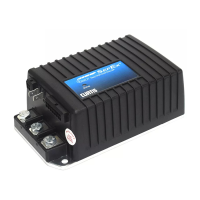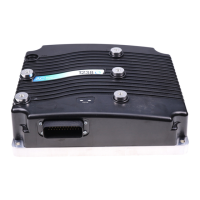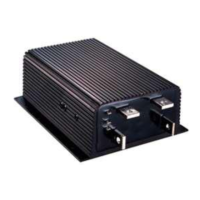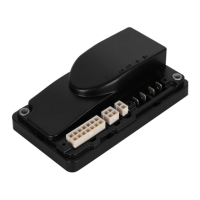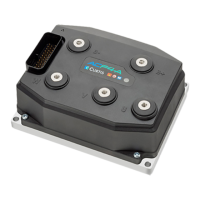36
Curtis 1230 Manual, Rev. C
CONTROL MENU
ALLOWABLE
PARAMETER RANGE DESCRIPTION
P Gain 0.00–1.00 The proportional gain and integral gain parameters define the gain of the
proportional and integral fractions of the PI slip control. The optimum set
-
tings of these parameters depend on the mechanical design of the vehicle
and drive train, which means they must be adjusted empirically through
experimental testing.
If these parameters are set too low, response to load or throttle steps
is slow. Setting them too high can result in jerky drive operation or in speed
oscillation.
I Gain 0.00–1.50 See P Gain, above.
Accel Slip, 1.0–50.0 Hz The accelerating slip and regenerating slip parameters define the maxi-
Regen Slip mum slip during acceleration/deceleration for the constant torque operating
area (see Figure 16).
Accel slip should be set according the full load slip (maximum cur
-
rent/ maximum torque at nominal motor voltage). Regen slip is typically set
about 20% lower, to limit peak current during regeneration because the
current vs. slip characteristic is steeper than for acceleration.
Slip Boost 0–10 Defines the slope of the slip vs. speed characteristic when the controller
goes into field weakening. This parameter can be used to adjust constant
maximum current in the constant power operating range (see Figure 16).
Pull-Out Slip 1.0–50.0 Hz Defines the maximum slip for the high speed operating area (see Figure
16). It should be set with sufficient safety margin below the motor’s pull-out
slip at the maximum motor current. Setting it too high may result in oscilla
-
tion or torque foldback.
Accel Slip Voltage, 0.0–10.0, Define the maximum slip voltage that is added to the V/f profile when
Regen Slip Voltage 0.0–5.0 maximum slip (and therefore full torque) is requested near zero speed.
These parameters allow independent adjustment of the maximum current
for accelerating and regenerating (braking).
It must be verified that the maximum motor current does not exceed
the motor’s rated maximum current or the controller’s 2-minute rating
*
under full load conditions.
Accel Comp, 0.0–5.0 Used to compensate for stray reactance effects. With low compensation
Regen Comp values the motor current and torque are reduced with increasing speed.
Typically these values are adjusted so that the maximum motor current is
constant within the constant torque operating area (see Figure 16).
It must be verified that the maximum motor current does not exceed
the motor’s rated maximum current or the controller’s 2-minute rating
*
under full load conditions.
Regen Voltage Offset 0.0–5.0 Used to prevent excessive regenerating motor current at low speeds. If the
motor current during braking is too high at low speeds, the maximum motor
voltage can be reduced by increasing the regen voltage offset.
* The 2-minute current rating depends on the controller model;
see specifications in Table C-1 for the rated current of your model.
3 — PROGRAMMABLE PARAMETERS:
Motor Control Parameters
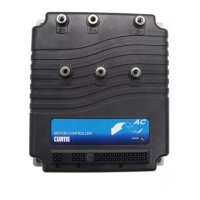
